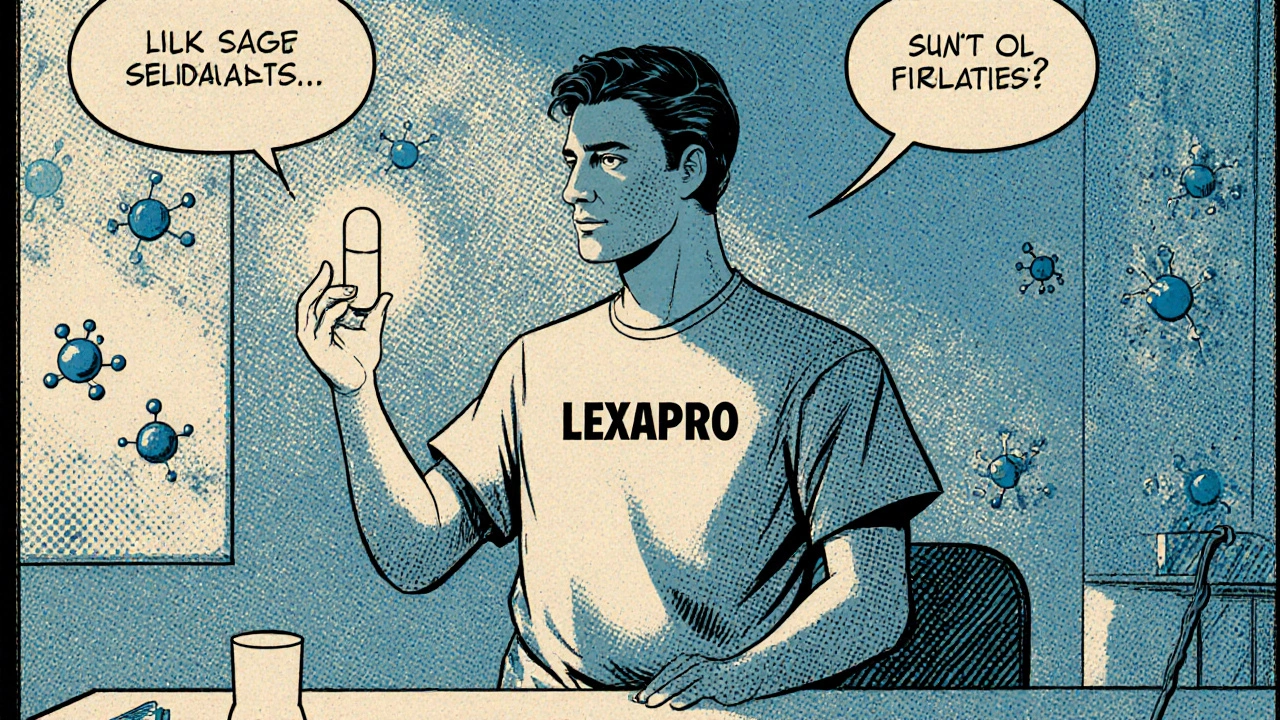Lexapro vs Other Antidepressants: How Escitalopram Stacks Up

Antidepressant Decision Guide
Find the right antidepressant for your needs
This tool helps you consider key factors that influence antidepressant effectiveness based on your specific symptoms, side effect concerns, and personal preferences. Answer a few questions to get personalized recommendations.
1. What are your primary concerns?
2. What side effects are most important for you to avoid?
3. What other factors are important?
What makes Lexapro stand out?
When you hear the name Lexapro, most people think of a calm, reliable way to lift mood. In reality, Lexapro is the brand name for escitalopram, an SSRI (selective serotonin reuptake inhibitor) that was approved in 2002. It works by increasing the amount of serotonin-a mood‑regulating neurotransmitter-in the brain, which helps smooth out the highs and lows of depression and anxiety.
Escitalopram is a highly selective SSRI that blocks the reabsorption of serotonin, allowing more of the chemical to stay in the synaptic gap. Its chemical structure is a single enantiomer of citalopram, which gives it a slightly stronger effect at a lower dose.
How do doctors decide which antidepressant is right?
Choosing an antidepressant isn’t a one‑size‑fits‑all decision. Clinicians weigh several factors:
- Effectiveness for specific symptoms - some drugs calm anxiety better, others boost energy.
- Side‑effect profile - weight change, sexual dysfunction, sleep impact.
- Onset of action - how quickly you’ll notice improvement.
- Drug interactions - especially important if you’re on other meds.
- Cost and insurance coverage - generic options can save a lot.
Head‑to‑head: Lexapro vs popular alternatives
Below is a quick‑read table that lines up the most common antidepressants against the criteria above. All doses are typical adult ranges for depression.
| Drug (Brand) | Class | Typical Dose | Common Side Effects | Onset (weeks) | Average Monthly Cost (CAD) |
|---|---|---|---|---|---|
| Lexapro | SSRI | 10-20mg | Nausea, insomnia, sexual dysfunction | 2-4 | ≈$45 (brand) / $12 (generic) |
| Zoloft | SSRI | 50-200mg | Diarrhea, dizziness, dry mouth | 2-4 | ≈$30 (generic) |
| Prozac | SSRI | 20-40mg | Loss of appetite, anxiety, sexual issues | 3-5 | ≈$25 (generic) |
| Effexor | SNRI | 75-225mg | Increased blood pressure, nausea, insomnia | 2-3 | ≈$40 (generic) |
| Wellbutrin | Atypical (NDRI) | 150-300mg | Dry mouth, insomnia, seizure risk at high doses | 2-3 | ≈$35 (generic) |
| Remeron | NaSSA | 15-45mg | Weight gain, sedation, increased appetite | 2-4 | ≈$38 (generic) |
| Cymbalta | SNRI | 30-60mg | Dry mouth, constipation, fatigue | 2-4 | ≈$45 (generic) |

Spotlight on the top alternatives
Not every drug in the table fits every person. Here’s a quick look at when you might reach for one of these instead of Lexapro.
Sertraline (Zoloft)
Sertraline is another first‑line SSRI, but it tends to be better for patients who also struggle with obsessive‑compulsive symptoms. Its half‑life is shorter than Lexapro’s, which can make switching off easier, but also means you might feel withdrawal symptoms sooner if you stop abruptly.
Fluoxetine (Prozac)
Fluoxetine has the longest half‑life of any SSRI-up to several weeks. That long tail can be a blessing for people who miss a dose, but it also means drug interactions linger. It’s often chosen for patients who need a more “activating” effect because it can boost energy and help with fatigue.
Venlafaxine (Effexor)
Venlafaxine belongs to the SNRI class, meaning it hits both serotonin and norepinephrine. This double‑hit can be useful when depression comes with significant pain or low motivation. However, it can raise blood pressure, so regular monitoring is a must.
Bupropion (Wellbutrin)
Because bupropion works on dopamine and norepinephrine, it has a lower risk of sexual side effects-a common complaint with SSRIs. It also helps with smoking cessation. The trade‑off is a modest seizure risk at higher doses, so it’s not ideal for people with a history of seizures.
Mirtazapine (Remeron)
Mirtazapine is famous for its sedating properties, making it a go‑to when insomnia rides shotgun with depression. It also tends to cause weight gain, which can be a blessing for patients who have lost appetite, but a downside for others.
Duloxetine (Cymbalta)
Duloxetine, another SNRI, shines in cases where chronic pain (like fibromyalgia or diabetic neuropathy) coexists with mood issues. Like venlafaxine, it needs blood‑pressure checks, but it’s generally easier on the stomach than some SSRIs.
When Lexapro is the right pick
If you value a relatively clean side‑effect profile, a simple once‑daily dosing schedule, and you’re starting treatment for moderate depression or generalized anxiety, Lexapro often tops the list. Its high selectivity means fewer off‑target effects, and many patients report feeling steadier mood changes after the first month.
Safety notes you can’t ignore
All antidepressants carry a black‑box warning about increased suicidal thoughts in people under 25. If you’re a teenager or young adult, monitor mood closely during the first weeks.
- Pregnancy: Lexapro is category C; it’s considered relatively safe but discuss alternatives with your OB‑GYN.
- Drug interactions: SSRIs can boost levels of certain blood thinners (e.g., warfarin) and some migraine meds (triptans).
- Withdrawal: Stopping any antidepressant abruptly can cause “discontinuation syndrome.” Taper slowly under medical supervision.
Cost considerations in Canada
In 2025, most provincial drug plans list generic escitalopram at about $12‑$15 per month, while brand‑name Lexapro sits around $45. If you have a limited formulary, your pharmacist may suggest switching to citalopram (Celexa) - a cheaper, non‑enantiopure version that works similarly but may require a slightly higher dose.
Putting it all together: a quick decision guide
- Primary goal is anxiety relief with minimal sedation? Lean toward Lexapro or Sertraline.
- Need an energizing boost or you’ve lost appetite? Try Fluoxetine or Bupropion.
- Chronic pain is a big part of your picture? Consider Venlafaxine or Duloxetine.
- Sleep is a nightmare? Mirtazapine’s sedating effect can double‑duty.
- Cost is the biggest barrier? Generic SSRIs (Escitalopram, Sertraline, Fluoxetine) are the most affordable.
Remember, the best choice is the one you can stick with. Side effects often fade after a few weeks, and a good therapist can help you navigate the adjustment period.
Frequently Asked Questions
How long does it take for Lexapro to start working?
Most patients notice a mood lift after 2-4 weeks, but full benefits can take up to 8 weeks. Patience and regular follow‑ups with your prescriber are key.
Can I switch from Lexapro to another SSRI without a washout period?
Because Lexapro’s half‑life is about 27‑32 hours, doctors often cross‑taper: gradually lower Lexapro while raising the new SSRI over 1-2 weeks. Always follow a clinician’s schedule.
Is Lexapro safe during pregnancy?
Lexapro is classified as pregnancy category C. It’s not linked to major birth defects, but doctors weigh the risk of untreated depression against medication exposure. Talk with your OB‑GYN.
Why do some people experience sexual side effects on Lexapro?
SSRIs increase serotonin, which can dampen libido and delay orgasm. If this becomes a problem, a doctor might add a low‑dose bupropion or switch to a non‑SSRI option.
How do I know if I’m on the right dose?
Start low (10mg for Lexapro) and increase after 2-4 weeks if symptoms persist and side effects are tolerable. Your clinician will track mood scores and any adverse effects to fine‑tune the dose.

Albert Lopez
October 15, 2025 AT 20:00While the article presents a comprehensive table, it neglects to mention the pharmacokinetic nuances that distinguish escitalopram from its racemic counterpart. The higher selectivity for the serotonin transporter does not automatically translate to superior clinical outcomes, as efficacy is mediated by patient-specific factors. Moreover, the discussion omits the impact of CYP2C19 polymorphisms on plasma concentrations, which can be clinically relevant. A rigorous analysis would also consider the comparative half‑life, which influences tapering strategies and discontinuation syndromes. In sum, the piece would benefit from a more granular appraisal of metabolic pathways and individualized therapy.
Halle Redick
October 26, 2025 AT 00:27Great rundown! I love how you broke down the side‑effects and costs – that really helps folks make sense of what’s right for them. It’s cool to see the table, because visual aids make the differences pop. If you’re in Canada, the generic price point is a big win. Keep the friendly vibe, it makes a heavy topic way easier to digest.
Erica Harrington
November 5, 2025 AT 03:54Thanks for the thorough comparison! I appreciate the balanced tone – you don’t push one drug over another, which is exactly what patients need. The decision guide at the end is a handy checklist for anyone meeting with their prescriber. Let’s keep sharing these practical resources so more people feel empowered about their treatment options.
Patricia Mombourquette
November 15, 2025 AT 08:20This article miss the point about cost differences.
karl lewis
November 25, 2025 AT 12:47One might argue that the superficial overview presented here borders on the platitudinous, yet it fails to grapple with the ontological implications of pharmacotherapy as a societal construct. Indeed, the very act of categorizing antidepressants into neat matrices obscures the lived phenomenology of depression. Nonetheless, the table does provide a semblance of order, which, for the lay reader, is a modest consolation :). In the grand tapestry of mental health discourse, such reductionist attempts are, unfortunately, inevitable.
Amy Martinez
December 5, 2025 AT 17:14Your article really hits home. I’ve watched friends wrestle with side effects, and the clear breakdown of which meds cause what can be a lifesaver. The way you highlighted bupropion’s lower sexual side‑effect profile was especially useful – that’s often a deal‑breaker. Also, the nod to medication cost in Canada shows you understand real‑world constraints. Keep weaving those personal nuggets into the science; it makes the information feel human, not just clinical.
Josh Grabenstein
December 15, 2025 AT 21:40Interesting read but beware how pharma pushes narratives. They want you to think every SSRI is interchangeable – that’s a myth. Look at the hidden data on serotonin syndrome that never makes the headlines :) The truth is buried, and we must question every “standard” guideline.
Marilyn Decalo
December 26, 2025 AT 02:07Wow, another “just pick a pill” guide. As if it’s that simple when you’ve got a brain chemistry labyrinth! The drama of side‑effects is real, but the article glosses over the emotional roller‑coaster of trial and error. Still, the tables are slick, so kudos for the aesthetic.